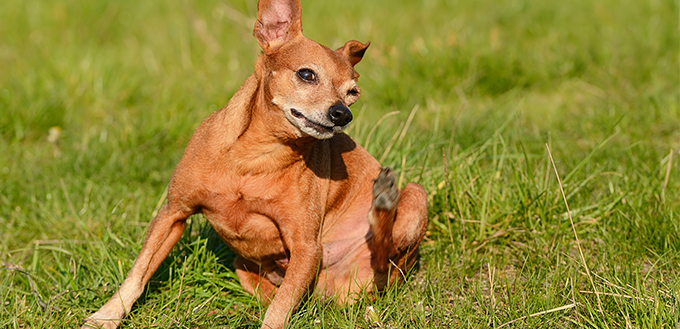Fleas are just some of the world’s peskiest critters. Regardless of how much you treat your dog year in and year out they still manage to come back for more rounds. These are very resilient creatures that first hide their eggs and juveniles in small cracks and crevices until they sense it’s time to latch onto a dog’s hair and start wreaking havoc. You treat your dog one time and the fleas go away. After a few months, they return. So, you add your flea collar and treat your dog, again. And the cycle continues. Isn’t there an end to this? Is it even possible to find a more permanent answer to the question of how to get rid of fleas on dogs?

Why Fleas are a Concern
Fleas are so small but they are very prolific jumpers. These 6-legged parasites live off the blood of their hosts and are known to jump more than a hundred times the length of their bodies. That is one amazing feat for a creature that is often the subject of massive search-and-destroy operations on our dogs. Unfortunately, the harm these critters bring to our pets is no laughing matter. Here are some of the most common reasons why fleas are a major concern.
- Cause flea bite dermatitis in susceptible dogs
Flea bite dermatitis produces a very intense itching sensation that will make your pet scratch like mad. Scratching itself is not bad. Sadly, if your pet’s paws have not been trimmed or the nails have not been clipped, there’s a strong chance that the constant scratching will lead to breaks in the integrity of the skin. This provides a gateway for microorganisms to enter your dog’s body and produce inflammatory reactions inside. In such cases, not only will you have to treat your pet for flea infestation, you will also need medications for its allergy and ensuing infection.
You May Also Like: Dog Nail Clippers & Grinders
- Produce tapeworm infections
If your pet inadvertently ingests fleas that have been initially infected with tapeworms, there is a great chance that your pet will also be developing tapeworm infection. Tapeworms are parasites that live off the nutrients and fluids that are present in your pet. Instead of your pet benefiting from the nutrients found in its food, these are essentially ‘sucked’ by the tapeworms themselves. Tapeworms induce malnutrition in severely affected dogs because nutrients are no longer absorbed by the dog’s intestines but rather by the tapeworm.
- Cause anemia
Flea bite anemia is not a problem in adult dogs, unless they have been infested by a multitude of fleas. This is more a concern of puppies as their smaller body surface area often magnifies even the slightest insult to their physiologic integrity. Fleas feeding off the blood of puppies can lead to a reduction in the red blood cells of these puppies, leading to anemia. Because there is insufficient RBCs, many cells don’t get oxygen and they eventually die. Pups won’t be able to move as much because doing so further depletes their oxygen stores.
- Facilitate the transmission of the plague
Did you know that the plague that wiped out 50 million people in the 14thcentury was brought, in part, by fleas? Yersinia pestis, the bacteria that cause plague, infects fleas which, in turn, bite rats and passes these bacteria onto other animals or even human beings that the rat bites or gets in contact with.
Related Post: Best Flea Killer For Your Yard

Related Post: Best Dog Flea Comb
Understanding Integrated Pest Management
There are three classes of anti-flea medications that are currently available in the market. Each class targets a specific phase in a flea’s life cycle to halt its development, if not render it incapable of reproducing. This is the theoretical basis of Integrated Pest Management protocols.
To understand how these works, you need to appreciate the life cycle of fleas. It always starts with an egg that hatches into tiny larvae after about 1 to 2 weeks. Another 1 to 2 weeks and the larvae turns into a pupae, pretty much like the cocoon of butterflies. The flea locks itself up in the cocoon for about a week before it comes out as an adult flea. This adult version has 1 to 3 months to lay eggs and feed off the blood of animals, particularly your dogs.
Based on the IPM model, getting rid of fleas on dogs requires the application of at least two different anti-flea molecules, basically to:
- Kill adult fleas already on the dog
Killing adult fleas involves the application of what are called adulticides or insecticides that specifically target the adult fleas. The reason for this is quite simple. Killing adult fleas on your dog halts their blood-sucking activity and prevents them from laying eggs that can develop into adult fleas in as short as 3 weeks. Furthermore, killing adults will also help arrest the ongoing harm or damage on your dog’s tissues and cells. Examples of adulticides include pyrethrin, permethrin, selamectin, imidacloprid, nitenpyram, and spinosad, as well as a host of others. Do understand that most of these preparations are to be applied onto your dog’s skin so it’s always best to check with your veterinarian if your dog is hypersensitive to these active ingredients or any other component of the adulticide.
- Disrupt the normal growth and development of non-adult fleas
You may have killed all of the adults, but that doesn’t mean the eggs, larva, and pupae are also eradicated. To address these flea stages, you will need a variety of other chemicals to apply onto your dog as well as the surroundings that your pet frequents on.
Insect Growth Regulators – These products are effective against eggs and larvae by introducing mimicking the characteristics of the critter’s natural growth hormone. This growth hormone is essential in their development towards the pupal stage where they molt and become adults. By providing this fake growth hormone, these insects don’t reach the adult stage. In a way, it is like killing these immature fleas slowly. The good thing is that they don’t know that the hormone they have is actually leading to their demise. Examples of insect growth regulators include methoprene, pyriproxyfen, and fenoxycarb.
Insect Development Inhibitors – There is another group of insecticides that work by disrupting the ability of these insects to produce the hard shell that protects them from being squashed. Ever recall having caught a flea and you tried squishing it in your fingers, only to see it jumping off to escape? Fleas have very tough outer shell that is amazingly resistant to large amounts of trauma and pressure. Insect development inhibitors or IDIs prevent the development of this natural biological defense so fleas become more susceptible to other forms of extermination. Excellent examples of IDIs include lufenuron and diflubenzuron.
Related Post: 5 Signs Your Dog Has Fleas
The Importance of Environmental Control
Killing adult and disrupting the growth and development of eggs and larvae won’t stop the flea menace. Why? Eighty percent of the fleas in your place are in the eggs and larvae form with only 2 percent being the adults. That means you have roughly 18 percent as pupae. These are very difficult to eradicate and these are often hidden in crevices, cracks, and nooks and crannies of your home and in the environment. Within a week, these will turn into adult fleas. That is why it is imperative to observe some form of environmental control to make sure you minimize the flea infestation. Here are some tips.
- Consider hiring a professional especially in spraying or fogging your property with an appropriate combination of adulticides and IGRs and/or IDIs. The pressurized fogging helps reach deep crevices that may otherwise not be reached by DIY spraying.
Related Post: Best Flea Carpet Spray & Powders
- Frequent vacuuming of your floors and carpets is a must. However, because these are very tiny insects, it is imperative that you use adequate protection to prevent inhaling these critters. It is also suggested that you dispose of the vacuum bag immediately after cleaning. Vacuuming has been shown to kill up to 96 percent of all adults and 100 percent of younger fleas.
Related Post: Best Vacuum for Pet Hair
- Get a good amount of diatomaceous earth and sprinkle generously on suspected flea hideouts. If you can, try covering the entire property. Diatomaceous earth has excellent physico-sorptive and abrasive properties that effectively dehydrate insects like fleas. Diatomites are known to absorb the lipids from the exoskeletons of fleas, killing them because of a loss of water pressure.
- You may also consider applying borax on affected surfaces. This has almost the same dehydrating effects like diatomaceous earth. Unfortunately, it may not really be safe for your pets.
- Increasing the temperature can also kill fleas as these pests are not known to be resilient against high heat. If you suspect clothing to have fleas, then you might want to throw these in your dryer at the highest setting.
- You can also try ‘flooding’ the suspected areas with soapy water or the addition of surfactants. However, it is important to ‘drown’ these pests by no less than 24 hours as anything less doesn’t really ensure their permanent extermination.
- Some natural remedies have also been recommended. The use of dried penny royal has been proven effective. Unfortunately, it is also toxic to other animals.
- Look at trying a flea treatment for dogs that are highly effective at controlling these pests.
Getting rid of fleas is very important if you don’t want your pets to suffer dermatitis, tapeworm infection, anemia, or even plague. You can use a combination of adulticides and specialty preparations to kill and manage existing fleas. However, to really get rid of these pests, you need to include environmental controls, as well.
Sources:
- Ernest Ward, DVM, Flea Control in Dogs, VCA
- Kate O’Hara, Protecting Your Pet from Fleas and Ticks, The MSPCA–Angell
- How to Handle Fleas on Dogs, PetMD
- Should You Fear the Flea?, ASPCA







